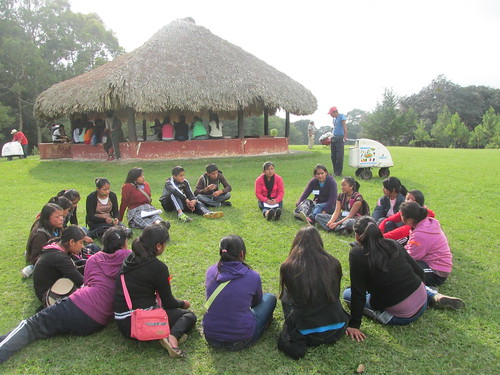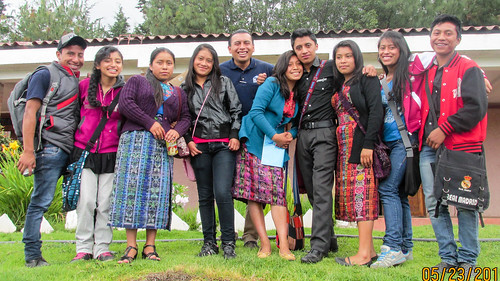Show of hands if you’ve gone on tour and seen this guy at an activity with our Scholarship & Youth Development Program students:
Yeeaahh, that’s what we thought. As many of you know, Samuel—our Scholarship Coordinator—is the MAN. He does so much for our students, both from a 10,000-foot perspective, and on a personal, individual level. He knows (probably better than anyone else) about their home lives, challenges, successes, and transformations. That’s why, when we were getting ready to launch our Thousand Girls Initiative, we took a moment to sit down with him and get his thoughts on where our students come from, the journey that they take through the program, the philosophy that motivates what we do, and his vision for their future.
What he said brought tears to our eyes. We dare you not to be moved!
What are the situations that our students come from like? What are their families and their homes like?
Although they all come from poor families, their situations are varied. Some are orphans, some have been abandoned by one parent, others have both parents but receive emotional support only from their mother, and some have parents who, in spite of their poverty, are enthusiastic about their children’s education and believe in a better future. We also have students who experience various degrees of violence at home. Their cases are diverse.
Their houses are very humble; many are made out of corrugated steel or clay and are quite small. It’s common to have a single-room house of about 12 by 18 feet in which various family members live. As far as I am aware, none of our students have their own bed, but share with some other member of the family. The houses are not equipped with any modern conveniences, and sit on very small parcels of land: I would guess that on average they’re about 60 by 60 feet.
In your opinion, what are the most important aspects of the Scholarship Program?
Every aspect of the program is important in an integral way to the whole, but I can highlight a few things:
1) The support we give to our at-risk students, whether that risk is social or academic. We visit their houses and schools, have individual meetings with them, and constantly evaluate their progress. We aren’t the experts; they are. (This is part of how we teach empowerment.) We simply help them to identify the principal cause of the problem and define concrete actions they can take to eliminate it. “Academic risk” refers to low grades (which can be related to other factors), while “social risk” can refer to violence, lack of emotional support from parents, extreme poverty, dysfunctional families, in some cases sexual abuse, and many more things. Social risk is widespread so we focus a lot of attention there and make sure to follow-up when a problem has been identified.
CoEd creates an environment free from violence in which the entire focus is on the students’ strengths and building resilience (self-possession) in the face of these situations. Doing this helps them to trust us, which is very important to the success of the program.
2) The youth development component, which consists of workshops and activities that help them develop life skills.
Can you tell me more about the goal of the youth development component, which includes workshops, visits to local businesses, and community service?
Sure. The concept of the program is to ‘empower them as agents of their own growth’ and help them to develop the ‘self-esteem, skills, and values’ that will enable them to reach their goals. We want our graduates to become professionals who break the cycle of poverty while maintaining core values and a commitment to helping others. The goal is to create a sense of solidarity in which they support each other and aim to work toward social justice and the common good.
The character strengths taught in the workshops are: grit, zest, self-control (when it comes to school work and interpersonal communication), optimism, gratitude, social intelligence, and curiosity.
How do the students typically change and mature throughout the course of the program? Can you give any specific examples?
Most of our students live in fairly negative home environments, which impairs the development of key strengths we strive to help them learn. But I’ve noticed that they generally get better at critical thinking (i.e. They have opinions and are able to analyze others’ opinions.), they exhibit better interpersonal skills with their classmates, and they become better leaders.
One scholarship student who has made a lot of progress is Alejandra María Yaní, who is in the ninth grade. When she began seventh grade she didn’t know how to write and had serious learning difficulties. She failed five subjects her first quarter, but the problem wasn’t that she didn’t want to learn; she had learning difficulties that we think are a result of the poor nutrition she’s had throughout her life. She failed a few classes the second quarter as well, but they were fewer, and the program began to take effect. At the end of the year she succeeded in passing all of her classes and her confidence in herself had grown dramatically. Her communication with her teachers improved as well. She has been extremely shy—when she has a problem she doesn’t show it—but I can still see how she has grown during the two years that she’s had the support of the program.
Her parents had begun to think that she was ‘incapable and couldn’t do it’ but it was interesting to see how their opinions changed and they began to support her more as she overcame her difficulties.
What are your hopes for our Scholarship Program graduates?
I hope that when they graduate they become competent and moral professionals who contribute to the development of their country. I believe they will be the ones who change Guatemala as they assume roles as professionals, business owners, and fathers and mothers, and that they will be the first of many more generations with better opportunities and a solid foundation of values.
I hope that they have a better future. When I visit our students’ homes there is a sentence I hear a lot from parents, which is short but profound: I want my child to study because I don’t have anything to leave them, and I know that education is their only chance for a better future. When I look at our students I see the next generation of teachers, secretaries, managers, business owners, doctors. I dream of a future in which we have a “Society of CoEd Graduates” made up of professionals who contribute a small part of their salaries each year to cover the costs of sending the next generation to school through our program.* I imagine a group of prosperous young people who above all promote social justice—who strive for equal rights, who are honest and will not compromise their values, and who are sympathetic to the people around them. Young people who live with dignity and inspire those around them to do the same through their attitudes and their behavior. I hope they promote a society based on the dignity of the human person, in which people help each other and strive for equality. I imagine a group of professionals who are not mediocre but competitive, and who believe it is their responsibility to make this country and the world a better place to live.
The investment our sponsors are making in the scholarship students will create a generational change in their communities.
Inspired yet?
*Looks like Samuel’s vision is already coming true…did you hear about our scholarship students who offered their hard-earned funds to bring another girl into the program?






